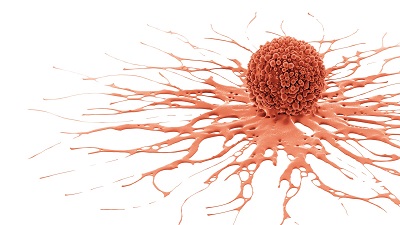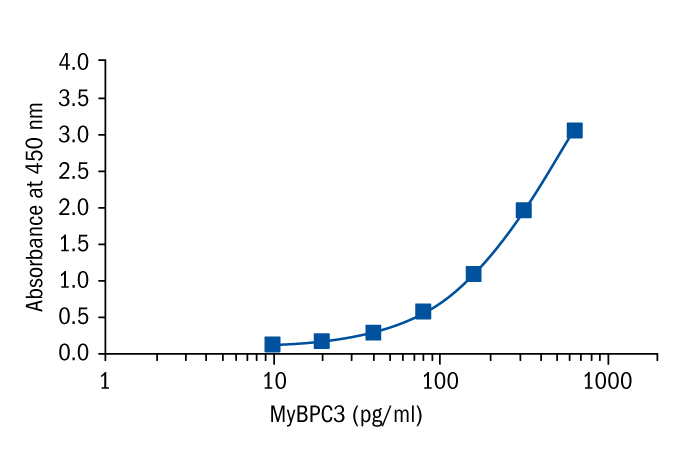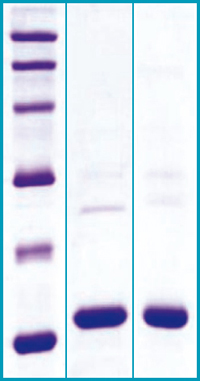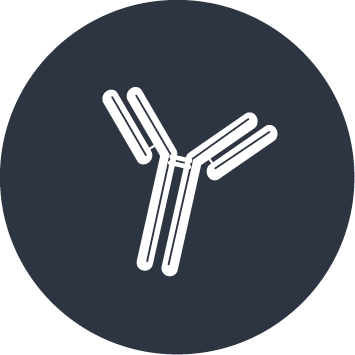Update 2026: miREIA assay kits have been discontinued as of January 1, 2026. The microRNA project now continues exclusively on the Two-Tailed RT-qPCR (TT-PCR) platform.

Dear customer, we would like to introduce our new products from January 2019 and hope you will find them interesting. Below is a list of events, in which we plan to participate in 2019:
AACC 2019 (04 \ 08 \ 2019 - 08 \ 08 \ 2019 – Anaheim)
MEDICA 2019 (18 \ 11 \ 2019 - 21 \ 11 \ 2019 – Düsseldorf)
NEW miREIA KITS
| CAT. NO. | STATUS | NAME | ASSAY FORMAT |
| RDM0028H | New | hsa-miR-26b-5p miREIA | miREIA – miRNA enzyme immunoassay |
| RDM0020H | New | hsa-miR-92a-3p miREIA | miREIA – miRNA enzyme immunoassay |
| RDM0017H | New | hsa-miR-155-5p miREIA | miREIA – miRNA enzyme immunoassay |
| RDM0014H | New | hsa-miR-222-3p miREIA | miREIA – miRNA enzyme immunoassay |
| RDM0026H | New | mmu-miR-7052-5p miREIA | miREIA – miRNA enzyme immunoassay |
Featured product: hsa-miR-155-5p miREIA
It is well-known that miR-155-5p is a proinflammatory, oncogenic miRNA, often associated with inflammation, cancer, and cardiovascular diseases.
Immune system
- mainly expressed in the thymus and spleen
- highly expressed in activated B and T cells as well as in macrophages miR-155-5p controls the function of lymphocytes and dendritic cells and is critical for normal immune function
- 140 target genes encode for immunomodulatory proteins, tumor-suppressor proteins, and inflammatory-related proteins
Oncology
- in high levels in several solid tumors such as lung cancer, breast cancer, thyroid carcinoma, cervical cancer, and pancreatic cancer
- an indicator of poor prognosis for patients with these tumors.
- Overexpressed in hematological malignancies, such as chronic lymphocytic leukemia (CLL) pathogenesis and is a promising, independent biomarker of unfavorable prognosis in CLL.
Gastrointestinal tract
- Highly expressed during Helicobacter pylori infection
- Increased expression in patients with inflammatory bowel disease (IBD)
- Increased expression in patients with colorectal cancer (CRC).

For this and more BioVendor miREIA kits, please visit www.biovendor.com/mirna.
microRNAs (miRNAs) are a class of single-stranded non-coding RNA molecules with a length of 19-23 nucleotides. They play a role in negative post-transcriptional regulation by binding to complementary sequences on mRNA and blocking translation into protein.
miREIA is a BioVendor proprietary method based on the combination of immunoassay and molecular biological principles. The main advantage is the quantitative determination of miRNA concentrations.
See more about hsa-miR-155-5p miREIA.

NEW IMMUNOASSAYS
| CAT. NO. | SPECIES | NAME | ASSAY FORMAT |
| RD191470200R | Human | MyBPC3 ELISA | Sandwich ELISA, Biotin-labelled antibody |
| RD191470200R | Human | MyBPC3 ELISA | Sandwich ELISA, Biotin-labelled antibody |
Featured product: HUMAN MYOSIN BINDING PROTEIN-C3 (MyBPC3) ELISA
Cardiac MyBP-C may be more useful than the gold standard biomarker Cardiac Troponin I
Blood levels of the current gold standard cardiac biomarkers are very low during the initial stages of myocardial infarction (MI), making early diagnosis difficult. Plasma levels of MyBPC3 are significantly elevated in MI patients. MyBPC3 levels increase from baseline at 3 hours after MI and peak at 6 hours. This is faster than for Cardiac Troponin I, which is normally detected 6-12 hours after the onset of MI.
Cardiac MyBPC (cMyBP-C, MyBPC3) is a 140 kDa structural protein that is present only in the heart. It is phosphorylated by several kinases. Phosphorylation of MyBPC3 regulates myocardial function and confers resistance to proteolysis, preserving cardiac function post-myocardial infarction.
Dephosphorylation at Ser-273 and Ser-282 facilitates MyBPC3 degradation and release of a 40 kDa N-terminal fragment (C0C1f). This C0C1f fragment is pathogenic within cardiac tissue and it is released into the circulation. It was later established in vivo that the C0C1f fragment could cause cardiac dysfunction and heart failure.

Importantly, it was shown that plasma MyBPC3 levels are significantly raised in humans with hypertrophic cardiomyopathy undergoing trans-coronary ablation of septal hypertrophy.
- Validated for human serum and citrate plasma
- Excellent sensitivity (LOD 1.74 pg/ml)
See more about MyBPC3 Human ELISA
RELATED PRODUCTS
RD172470100 Myosin-binding protein C cardiac-type Human E. coli

NEW PROTEINS
| CAT. NO. | SPECIES | NAME | SIZE | SOURCE |
| RD272587025 | Mouse | Adiponectin, Tag free | 0.025 mg | HEK293 |
| RD272587100 | Mouse | Adiponectin, Tag free | 0.1 mg | HEK293 |
| RD172091025 | Human | Adiponectin, Trimeric form | 0.025 mg | HEK293 |
| RD1725740100 | Human | CCL17 | 0.1 mg | E. coli |
| RD162034100 | Human | Clusterin NATIVE | 0.1 mg | Human serum |
| RD176034100 | Human | Clusterin, Tag free | 0.1 mg | HEK293 |
| RD172566025 | Human | Interleukin-2 | 0.025 mg | E. coli |
| RD172566100 | Human | Interleukin-2 | 0.1 mg | E. coli |
| RD172571100 | Human | Interleukin-7 | 0.1 mg | E. coli |
| RD172058025 | Human | Myostatin Propeptide, Tag free | 0.025 mg | E. coli |
| RD172562025 | Human | Neurofilament light polypeptide | 0.025 mg | E. coli |
Featured product: HUMAN CCL17, E. COLI
Chemokine (C-C motif) ligand 17 (CCL17)/thymus and activation-related chemokine (TARC) is a CC chemokine secreted by PBMCs and various subsets of monocyte-derived dendritic cells, including thymic dendritic cells and endothelial cells. CCL17 interacts with CCR4 and CCR8 to induce the chemoattraction of activated Th2 cells, basophils, and NK cells. This chemokine specifically binds and induces chemotaxis in T cells and elicits its effects by interacting with the chemokine receptor CCR4. The gene for CCL17 is located on chromosome 16, in humans, along with other chemokines called CCL22 and CX3CL1.
CCL17 is associated with various mechanisms of the immune system and plays vital roles in such disorders as allergen-induced asthma and autoimmune diseases.
BioVendor Human CCL17 is a recombinant protein expressed in E.coli.
Total 78 AA. MW: 15 kDa (calculated). UniProtKB acc.no. Q92583 (Ala24-Ser94). N-terminal His-tag (7 extra AA). Endotoxin < 0.1 EU/µg. Protein identity was confirmed by LC-MS/MS.

14% SDS-PAGE separation of Human CCL17, E. coli:
1. M.W. marker – 14, 21, 31, 45, 66, 97 kDa
2. Reduced and boiled sample, 2.5 μg/lane
3. Non-reduced and non-boiled sample, 2.5 μg/lane
See more about Human CCL17, E. coli

NEW ANTIBODIES
| CAT. NO. | SPECIES | NAME | REACTIVE SP. | SIZE |
| RD1820261003G6 | Anti-Human | Cardiotrophin-1 | Mouse Monoclonal Antibody, Clone: 3G6D9 | 0.1 mg |
| RD1820341008H4-01 | Anti-Human | Clusterin | Mouse Monoclonal Antibody, Clone: 8H4 | 0.1 mg |
| RD484488100 | Anti-Canine | Fibroblast Growth Factor 21, Tag free | Sheep Polyclonal Antibody | 0.1 mg |
Featured product: ANTI-HUMAN CLUSTERIN MOUSE MONOCLONAL ANTIBODY, CLONE: 8H4
Innovated versions of highly popular with customers mouse MAb anti-human Clusterin, clone 8H4 is newly produced in vitro and isolated from the cell culture supernatant. Clusterin (Apolipoprotein J, ApoJ) is an extracellular chaperone protecting cells from stress induced by degraded and misfolded protein precipitates. It is able to bind and form complexes with numerous partners such as immunoglobulins, lipids, heparin, bacteria, complement components, paraoxonase, beta amyloid, leptin, and others. Clusterin has been ascribed a plethora of functions such as phagocyte recruitment, aggregation induction, complement attack prevention, apoptosis inhibition, membrane remodeling, lipid transport, hormone transport and/or scavenging, matrix metalloproteinase inhibition.

Clusterin is up- or downregulated on the mRNA or protein level in many pathological and clinically relevant situations including cancer, organ regeneration, infection, Alzheimer disease, retinitis pigmentosa, myocardial infarction, renal tubular damage, autoimmunity, and others.
Applications: ELISAClusterin is a 75–80 kD disulfide-linked heterodimeric protein containing about 30% of N-linked carbohydrate rich in sialic acid, but truncated forms targeted to the nucleus have also been identified. Across a broad range of species, clusterin shows 70% to 80% of sequence homology. It is ubiquitously expressed in most mammalian tissues and can be found in plasma, milk, urine, cerebrospinal fluid and semen.
See more about Anti-Human Clusterin, Mouse MAb, Clone: 8H4
RELATED PRODUCTS
RD491034200R Clusterin Canine ELISA
RD194034200R Clusterin Human ELISA
RD391034200CS Clusterin Rat ELISA
RD472034100 Clusterin Canine E. coli
RD472034100-HEK Clusterin Canine HEK293
RD172034100 Clusterin Human HEK293
RD176034100 Clusterin Human HEK293 Tag free
RD172034100-S Clusterin Human NATIVE, Human Plasma
RD162034100 Clusterin Human NATIVE, Human Serum
RD372034100 Clusterin Rat E. coli
RD481034100 Clusterin Canine, Rabbit Polyclonal Antibody
RD484034100 Clusterin Canine, Sheep Polyclonal Antibody
RD182034110-H3 Clusterin Human, Mouse Monoclonal Antibody, Clone: Hs-3
RD381034100 Clusterin Rat, Rabbit Polyclonal Antibody

NEW EXTRACELLULAR MATRIX ASSAYS
| CAT. NO. | STATUS | NAME | ASSAY FORMAT |
| RBCK1000 | Multispecies | Keratin Orange, (110 assays) [Standard Kit] | Colorimetric assay |
| RBCK5000 | Multispecies | Keratin Orange, (440 assays) [Economy Kit] | Colorimetric assay |
For these and more Extracellular Matrix Assays, please visit www.biovendor.com/extracsellular-matrix-assays.
BioVendor News Let's keep in touch!
Click to sign up for our newsletter to receive regular updates: NEWLETTER
More information about your data protection rights can be found at Privacy Policy

